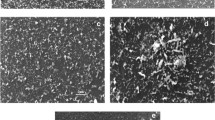Abstract
In this work, Ag doped In2O3 nanostructure materials were successfully synthesis using a simple hydrothermal process with different Ag concentration (3,6,9)%. The structural properties and morphology of the obtained nanostructure film are characterized by X-ray diffraction and field emission scanning electron microscopy (FE-SEM). The structural analysis shows a highly crystalline of indium oxide with a cubic phase and the crystallite size decreased with the increasing of doping concentration. The current–voltage results from devices indicate that In2O3 film with 9% Ag concentration has better conduction film. Gas sensing performance was studied for NO2 gas with different concentration (50,100,150) ppm at operating temperature 100 °C. The maximum sensitivity (S = 79 %) was found at doping concentration 9% Ag.
Similar content being viewed by others
References
Comini E, Baratto C, Faglia G, Ferroni M, Vomiero A, Sberveglieri G (2009) Quasi-one dimensional metal oxide semiconductors: preparation, characterization and application as chemical sensors. Prog Mater Sci 54:1–67
Dong Q, Su H, Zhang D, Zhang F (2006) Fabrication and gas sensitivity of SnO2 hierarchical films with interwoven tubular conformation by a biotemplate directed sol–gel technique. Nanotechnology 17:3968–3972
Liu X, Zhou L, Yi R, Zhang N, Shi R, Li Y, Gao G, Qiu G (2008) Single-crystalline indium hydroxide and indium oxide microcubes: synthesis and characterization. J Phys Chem 15:134
Thong LV, Hoa ND, Le DTT, Viet DT, Tam PD, Le A-T, Hieu NV (2010) On-chip fabrication of SnO2-nanowire gas sensor: the effect of growth time on sensor performance. Sens Actuators B Chem 146:361–367
John Bosco Balaguru R (2009) Mimic of a gas sensor, metal oxide gas sensing mechanism, factors influencing the sensor performance and role of nanomaterials based gas sensors. School of Electrical & Electronics Engineering SASTRA University
Gaoa L, Chengb Z, Xiangb Q, Zhangb Y, Xua J (2015) Porous corundum-type In2O 3 nanosheets: synthesis and NO2 sensing properties. Sensors Actuators B 208:436–443
Cheng Z, Song L, Ren X, Zheng Q, Xu J (2013) Novel lotus root slice-like self-assembled In2O 3 microspheres: synthesis and NO2-sensing properties. Sensors Actuators B 176:258–263
Cheng1 G, Stern E, Guthrie S (2006) Indium oxide nanostructures. Appl Phys A 85:233–240
Cheng ZX, Dong XB, Pan QY, Zhang JC, Dong XW (2006) Preparation and characterization of In2O 3 nanorods. Mater Lett 60:3137–3140
Wang CY, Cimalla V, Romanus H, Kups T, Ecke G, Stauden T, Ali M, Lebedev V, Pezoldt J, Ambacher O (2006) Phase selective growth and properties of rhombohedral and cubic indium oxide. Appl Phys Lett 89:11904–11913
Mehta BR, Singh VN (2005) Structural, electrical and gas-sensing properties of In2O 3:Ag composite nanoparticle layers PRAMANA. Journal of Physics Indian Academy of Sciences 65(5):949–958
Aziz WJ, Jarhallah AK (2015) Effective doping concentration of indium on zinc oxide films using chemical spray pyrolysis technique. Optik - International Journal for Light and Electron Optics 126(20)
Bagheri Mohagheghi M, Shahtahmasebi N (2009) Effect of the synthesis route on the structural properties and shape of the indium oxide (In2O 3) nano-particles. Phys E 41:1757–1762
Ivanovskaya M, Gurlo A, Bogdanov P (2001) Mechanism of O3 and NO2 detectionand selectivity of In2O 3 sensors. Sens Actuators B 77:264–267
Gaoa L, Chengb Z, Xiangb Q, Zhangb Y, Xua J (2015) Porous corundum-type In2O 3 nanosheets: synthesis and NO2 sensing properties. Sensors Actuators B 208:436–443
Guo MY, Liu F, Tsui J, Voskanyan AA, NG AMC, Djurisic AB, Chan WK (2015) Indium oxide cubes prepared by hydrothermal synthesis as catalysts for CO oxidation. Mater Chem Phys 153:243–247
Song P, Han D, Zhang H, Li J, Yang Z, Wang Q (2014) Hydrothermal synthesis of porous In2O 3 nanospheres with superior ethanol sensing properties. Sensors Actuators B 196:434–439
Sun Y-F, Liu 3 S-B, Meng F-L, Liu J-Y, Jin Z, Kong L-T, Liu J-H (2012) Metal oxide nanostructures and their gas sensing properties:a review. Sensors 12:2610–2631
Acknowledgments
The authors would like to acknowledge the support from the staff of material Laboratory in physics department al Mustansiriyah University.
Author information
Authors and Affiliations
Corresponding author
Rights and permissions
About this article
Cite this article
Sabry, R.S., Agool, I.R. & Abbas, A.M. Hydrothermal Synthesis of In2O3 :Ag Nanostructures for NO2 Gas Sensor. Silicon 11, 2475–2478 (2019). https://doi.org/10.1007/s12633-018-9999-5
Received:
Accepted:
Published:
Issue Date:
DOI: https://doi.org/10.1007/s12633-018-9999-5




